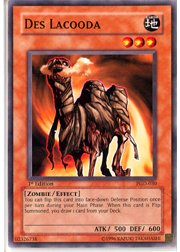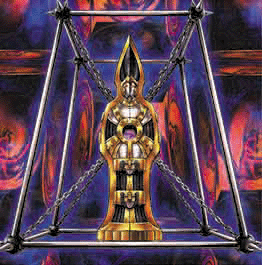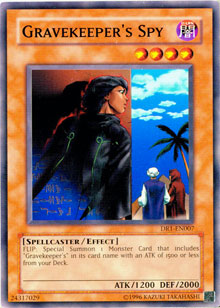With Shonen Jump Championship Los Angeles coming up, I’ve been contemplating which deck I should play. While I’m primarily a control and combo gamer, I haven’t overlooked the possibility of playing an aggro deck. It mostly depends upon what seems to work best in this format. Of course, looking into what deck to run takes work, and work is something that I normally try to avoid. Just ask my college professors, or our hard-working (and hardly mentioned) editors here at Metagame.com.*
The one thing I decided upon when approaching this tournament was that I would not run something that most tournament players would expect. I personally feel that running decks that most players expect (or run themselves, for that matter) greatly increases the luck factor of your tournament run. After all, the game would then be decided on how you play your cards, or simply who draws the right cards first. This immediately ruled out most popular choices, including Flip-Flop Control (a deck I’m not crazy about in the first place) and the seemingly outdated Soul Control. This also excluded any deck that abuses Treeborn Frog, since it’s a monster that most players are already planning on using or countering.
 My deck choices have come down to two options: heavy control and heavy aggro. Mono-Burn control (or Lava-Lacooda control, as I have referred to it in the past) is a deck that attempts to avoid the battle phase entirely. It generates advantage primarily off of Des Lacooda and other self-flipping monsters, while denial cards such as Solemn Judgment and Sakuretsu Armor dictate which of my opponent’s cards and attacks will resolve. The other deck choice is Gravekeepers, an archetype that has always been popular among certain crowds. Gravekeeper’s Assailant is simply absurd, especially in the Spirit Reaper environment. The addition of Spellcaster support cards, such as Magician’s Circle and Magical Dimension, have also added a lot to the archetype.
My deck choices have come down to two options: heavy control and heavy aggro. Mono-Burn control (or Lava-Lacooda control, as I have referred to it in the past) is a deck that attempts to avoid the battle phase entirely. It generates advantage primarily off of Des Lacooda and other self-flipping monsters, while denial cards such as Solemn Judgment and Sakuretsu Armor dictate which of my opponent’s cards and attacks will resolve. The other deck choice is Gravekeepers, an archetype that has always been popular among certain crowds. Gravekeeper’s Assailant is simply absurd, especially in the Spirit Reaper environment. The addition of Spellcaster support cards, such as Magician’s Circle and Magical Dimension, have also added a lot to the archetype.
While I’m most likely going to be skipping over Gravekeepers in order to favor my “draw cards and end my turn” deck, seeing what Magical Dimension does with Gravekeepers is particularly intriguing. The archetype and Magical Dimension work well together, and seeing its use at a local tournament led me to read up on this quick-play spell’s rulings. It’s definitely an oddball option, but it’s also one of the most powerful cards that I’ve seen.
Breakdown and Strategies
 Magical Dimension is the pinnacle of Spellcaster-oriented support. It can only be activated while you control a Spellcaster-type monster, so splashing this quick-play spell into just any deck definitely isn’t an option The fact that you have to special summon a Spellcaster from your hand further restricts it—you can’t activate Magical Dimension unless you have a legal monster that you can special summon.
Magical Dimension is the pinnacle of Spellcaster-oriented support. It can only be activated while you control a Spellcaster-type monster, so splashing this quick-play spell into just any deck definitely isn’t an option The fact that you have to special summon a Spellcaster from your hand further restricts it—you can’t activate Magical Dimension unless you have a legal monster that you can special summon.
What’s particularly weird about this quick-play spell is that it has one of the most action-packed resolutions in the history of the Yu-Gi-Oh! TCG. At the resolution of Magical Dimension, you tribute one monster you control. It can be any monster, but it’s very strange, since most instances of tributing take place as a cost. Magical Dimension’s “cost” takes place as a resolution instead. You then special summon a Spellcaster-type monster from your hand. Afterwards, you have the choice to destroy one monster on your opponent’s field. The last line of this card is particularly headache-inducing, since it doesn’t cause you to target any monster when you activate Magical Dimension. Why? Because your spell card’s effect is optional, and you don’t choose a monster to destroy until resolution. This makes Magical Dimension very difficult to counter, since your opponent cannot easily react to it unless it involves wiping out all the monsters on the field before Magical Dimension resolves. I could go on about the one-of-a-kind nature of this card’s rulings, but I would simply be repeating exactly what Curtis said last Wednesday.
The key to Magical Dimension’s usefulness falls upon its spell speed of 2. Almost every single quick-play spell printed is worth a second look, and Magical Dimension is no exception. The effect itself is interesting, but if it were a normal spell card, it would be a very underpowered form of removal. The effect ultimately leads to reduced card presence, which means that you’ll be losing two cards while your opponent might lose only one. In fact, sometimes your opponent might not even lose a card at the end of your spell’s effect!
However, the quick-play spell card symbol instantly adds a whole new level of playability to Magical Dimension. The key aspect to quick-play spells is that they can be activated at practically any point during either player’s turn (excluding the damage step), unless the spell in question affects a monster’s ATK or DEF value, such as Rush Recklessly. In this case, Magical Dimension acts as a devastating defensive card or a deadly aggressive card. An aggressive player using Magical Dimension can activate it in response to Sakuretsu Armor on the offensive, and the attacking monster will be tributed in order to fizzle the effects. Your Magical Dimension will then replace your fallen attacker with a fresh new monster that’s free to smash your opponent’s face, since Magical Dimension also clears away any annoying monsters that he or she might have had. On the defensive, Magical Dimension can be used in response to Snatch Steal or Exiled Force, providing both protection from having your face smashed by Don Zaloog or Mobius the Frost Monarch, and the ability to destroy those monsters and others like them.
 The reason why Magical Dimension is so amazing in the Gravekeeper deck is because its versatility adds even more to an archetype that’s already amazingly versatile. The Gravekeepers have a solid form of recursion through Rite of Spirit, a solid search effect through Gravekeeper’s Spy, and a general win condition found in Necrovalley—which also happens to disrupt many popular card choices found in the Advanced format. Gravekeeper’s Spy is an amazing card on the defensive, but its flip effect is one of the most powerful tools available to an aggro player. A free special summon from your deck is not only advantageous in terms of card presence, but it also gives you massive field presence and the ability to quickly put pressure on your opponent by wrecking both his or her monsters and life points.
The reason why Magical Dimension is so amazing in the Gravekeeper deck is because its versatility adds even more to an archetype that’s already amazingly versatile. The Gravekeepers have a solid form of recursion through Rite of Spirit, a solid search effect through Gravekeeper’s Spy, and a general win condition found in Necrovalley—which also happens to disrupt many popular card choices found in the Advanced format. Gravekeeper’s Spy is an amazing card on the defensive, but its flip effect is one of the most powerful tools available to an aggro player. A free special summon from your deck is not only advantageous in terms of card presence, but it also gives you massive field presence and the ability to quickly put pressure on your opponent by wrecking both his or her monsters and life points.
Unlike a control match, where a control player is primarily concerned with numbers and controlling the general state of the game until he or she can win, an aggro player’s goal is to put pressure on the opponent. An aggro player gets into a player’s head very differently than a control player does. When playing against an aggro deck, one of the questions you may commonly ask yourself is, “Can my opponent kill me next turn?” The Gravekeeper deck is very good at pressuring your opponent into making hasty choices that cause him or her to fall out of his or her comfort zone. Magical Dimension not only gives an aggro deck such as Gravekeepers the ability to put even more pressure on the opponent by dealing game-winning damage a turn earlier through its special summoning capabilities, but it also acts as a powerful defensive card that aggro decks can fall back on.
Personally, one of my favorite tricks with Magical Dimension is the use of Gravekeeper’s Assailant’s effect multiple times during a battle phase. Gravekeeper’s Assailant is already effective in an environment where multiple Spirit Reapers are a common sight. Attacking and targeting Spirit Reaper with your Gravekeeper causes a replay that allows your Gravekeeper’s Assailant to attack again. Using Magical Dimension in response to your attack declaration with Gravekeeper’s Assailant allows you to switch the position of one of your opponent’s monsters. Specifically, it will allow you to special summon a larger monster in place of one of your smaller monsters, and the destruction effect of Magical Dimension will cause a replay to occur, since the number of monsters on the opponent’s field will change before your attack concludes. If you didn’t tribute Gravekeeper’s Assailant, it will be free to attack and switch another monster’s battle position. If you tributed Gravekeeper’s Assailant, you’re still going to be able to switch the battle position of one monster. It’s a nifty combo, despite the fact that its effectiveness is only seen on occasion.
Final Thoughts
Magical Dimension is an example of what type-specific support should look like. This spell’s quick-play status makes it amazingly versatile, able to wreck the opponent at the most inopportune time. It also makes the Gravekeepers a very threatening aggro deck, since Magical Dimension blurs the line between nearly full life points and a goose-egg life total. On that note, if any players out there are looking for any last-minute deck ideas for Shonen Jump LA, try messing around with Gravekeepers a bit. They’re not a bad choice for this Advanced format.
If you have any questions or comments regarding this or previous articles, feel free to email me at Mrosenberg at Metagame dot Com and I will try my best to get back to you.
*On that note, be sure to let the coverage team at the major events know how much you appreciate Mary and Toby’s dedication to the website. They give up their weekends in order to supply live coverage of the events that you want to keep up with. If it weren’t for them, live Metagame.com coverage would not be possible.